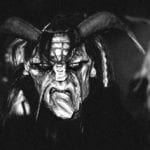 Politics
Politics  Politics
Politics  Weird Stuff
Weird Stuff Ten Bizarre Facts About The Doge Meme
 Our World
Our World 10 Ways Your Christmas Tree Is More Lit Than You Think
 Movies and TV
Movies and TV The 10 Coolest Stars to Set Sail on The Love Boat
 History
History 10 Things You Didn’t Know About the American National Anthem
 Technology
Technology Top 10 Everyday Tech Buzzwords That Hide a Darker Past
 Humans
Humans 10 Everyday Human Behaviors That Are Actually Survival Instincts
 Animals
Animals 10 Animals That Humiliated and Harmed Historical Leaders
 History
History 10 Most Influential Protests in Modern History
 Creepy
Creepy 10 More Representations of Death from Myth, Legend, and Folktale
 Politics
Politics 10 Political Scandals That Sent Crowds Into the Streets
 Weird Stuff
Weird Stuff Ten Bizarre Facts About The Doge Meme
 Our World
Our World 10 Ways Your Christmas Tree Is More Lit Than You Think
Who's Behind Listverse?

Jamie Frater
Head Editor
Jamie founded Listverse due to an insatiable desire to share fascinating, obscure, and bizarre facts. He has been a guest speaker on numerous national radio and television stations and is a five time published author.
More About Us Movies and TV
Movies and TV The 10 Coolest Stars to Set Sail on The Love Boat
 History
History 10 Things You Didn’t Know About the American National Anthem
 Technology
Technology Top 10 Everyday Tech Buzzwords That Hide a Darker Past
 Humans
Humans 10 Everyday Human Behaviors That Are Actually Survival Instincts
 Animals
Animals 10 Animals That Humiliated and Harmed Historical Leaders
 History
History 10 Most Influential Protests in Modern History
 Creepy
Creepy 10 More Representations of Death from Myth, Legend, and Folktale
10 Bizarre Discoveries From The World Of Batman
Between comics, cartoons, and movies, Batman is one of the most well-known American icons, one that has survived for 75 years. While many people think they know all about the character, a deeper look at his stories reveals facts and conclusions that are downright shocking.
10A Hacker Killed Robin

Most Batman fans know about the death of the second Robin. Jason Todd, who replaced original Robin Dick Grayson, was viciously beaten by a crowbar-wielding Joker and was left to die in an explosion. His fate went into the hands of readers, who could phone in and vote whether the Boy Wonder lived or died. More people voted for “dead” than “alive,” and DC Comics killed Robin in the name of democracy. But here’s the catch: The vote was rigged.
According to Batman writer Dennis O’Neil, one fan programmed a computer to repeatedly dial the number and vote for Robin to die. The computer cast the vote every 90 seconds for eight hours. The number of votes to kill Robin was only 28 higher than the number to spare him, so without this single crazed fan, Robin wouldn’t have died.
However, it could have been worse for Robin. Jim Starlin, who wrote both potential endings for Robin, actually wanted a third option—for him to succumb to AIDS.
9Rock Music: Batman’s Greatest Enemy
In the graphic novel Fortunate Son, Batman has a theory about what motivates criminal behavior: rock-and-roll music.
The story features DC’s version of Elvis Presley, who may or may not be responsible for a recent crime spree. Young Robin, of course, is a fan of the man’s music. To educate Robin about the evils of rock, Batman takes him to Arkham Asylum, which has multiple criminally insane Elvis impersonators. To top it off, Batman shows Robin some truly damning evidence: Joker and Two-Face like rock music (KISS and Black Sabbath, respectively).
The weirdness goes further when Batman reveals that he once spent weeks with a Sid Vicious look-alike. The man was “powerful in his madness” and would not let Bruce go, so Batman spent “weeks trapped in his obsession.” Bruce does not elaborate on what exactly that means. When he left the musician, the Sid stand-in killed a girl, leaving Batman haunted by rock forever.
To crack this most recent case, Batman forces himself to listen to rock music, while he screams out such fitting lyrics as “too much love . . . drives a man insane.”
8Joker Willingly Went To The Electric Chair
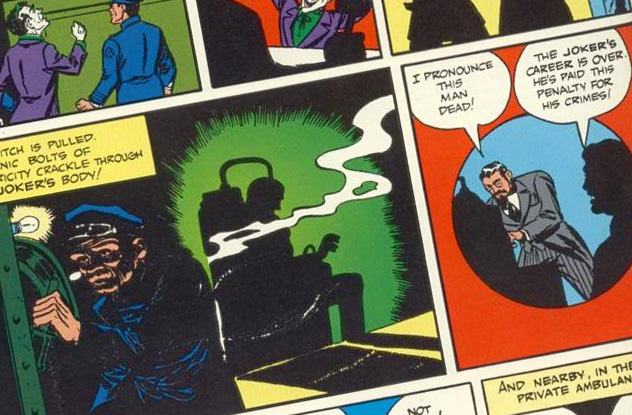
A popular conceit of modern Batman stories is that most of his rogues, being insane, can’t legally face execution. However, this wasn’t the case in 1942, when Joker concocted his boldest plan yet: letting Gotham City kill him.
Apparently, life has been a drag for the criminal mastermind. So he heads to the police station, admits to crimes both known and unknown, gets a speedy trial, and marches to the electric chair, where he is put to death. However, it’s all part of a larger plan.
The genius chemist who developed the Joker’s laughing gas also developed a special serum to bring him back to life. Joker’s goons bust in, steal his body, and give him the serum. This lets Joker have the last laugh: Neither Batman nor the police can now apprehend him because he has already been killed, paying his debt to society.
However, he gets too bold and tries framing Batman for a crime the caped crusader didn’t commit. When the plan collapses, things are back to normal: a car chase, a plane chase, and a watery escape for the Joker.
7Joker Is Not Crazy
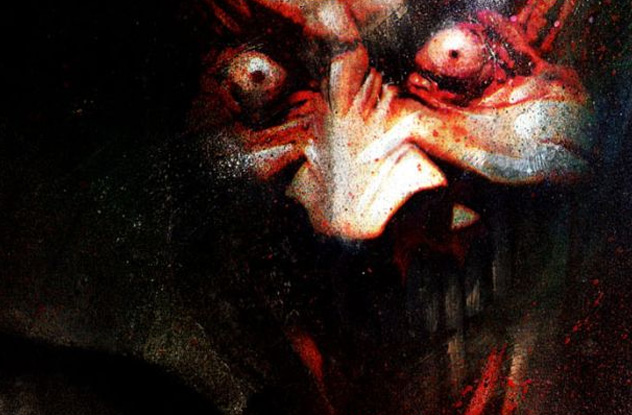
The Joker is Batman’s most well-known nemesis, embodying chaos in opposition to the Dark Knight’s attempts at order. Like most of Batman’s villains, Joker is often thrown into Arkham Asylum. But he may not be crazy at all. In fact, he may be just the opposite.
Scottish comics scribe Grant Morrison got his start by writing 1989’s trippy Arkham Asylum: A Serious House On Serious Earth. A psychologist in the comic says that Joker, instead of being truly insane, suffers from something called “super sanity.” Joker’s mind uniquely evolved to the 20th century and its barrage of stimuli by stripping itself of any sensory filters. He can’t control the info he takes in, and so he remakes himself day after day.
While this started as Morrison’s clever way of linking Joker stories together (and explaining why the character is sometimes portrayed as a ruthless killer and sometimes as a fun-loving clown), it eventually led to Morrison’s real-life belief that multiple personality disorder is “the next stage in human consciousness.”
6Batman Nearly Destroyed The Universe
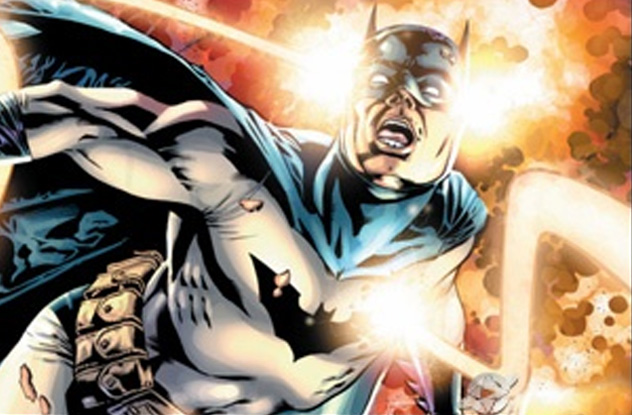
During “Final Crisis,” one of DC’s periodic Earth-shattering events, a distinctly out-of-character Batman tries to kill Darkseid using a gun loaded with (what else?) special god-killing ammo. However, Darkseid has time to shoot Batman with his own special “Omega Sanction,” seemingly frying the Bat to his bones.
The Return of Bruce Wayne reveals that the skeleton was a cloned fake. The Omega Sanction simply sent Wayne skipping back and forth through time. Darkseid was counting on Batman surviving and triumphing in every time period, each hop taking him further into the future and building up more Omega energy. When Batman hit the end of time, it would (somehow) destroy the entire universe.
Batman figured out the plan and outsmarted Darkseid. Still, there’s an admirable irony in Batman wielding a gun against a god and then becoming a bullet fired at the universe.
5Harley Quinn: Sex Jokes For Kids
Harley Quinn is a mainstay of the Batman universe, transitioning from Batman: The Animated Series to her own DC comic and finally appearing in the popular Arkham Asylum and Arkham City video games. Her kinky outfits in these games differ from her traditional harlequin get-up, so you might think the sex appeal was added to go along with the games’ more mature themes. However, while the outfit is new, DC’s writers have been associating Harley with sex since she debuted in the ’90s children’s cartoon.
In one memorable scene, Harley poses as an attorney, and Gotham detective Bullock wonders if he has seen her before. “I served you a subpoena once,” she tells him, followed quickly by: “It was a small subpoena.” In another episode, it’s Joker’s own “subpoena” she has trouble serving, when she tries seducing him by suggestively crawling on his work bench wearing only a negligee and mask. Joker is focused on his latest plan to kill Batman, leading a dejected Harley to ask, “Come on, don’t you want to rev up your Harley? Vroom vroom!”
But nothing can top the image of Harley emerging from a gigantic pie. Covered in white custard, she sings a weird variant of Marilyn Monroe’s sultry “Happy Birthday, Mr. President” before offering Joker a taste of “her pie” followed quickly by “I bet you’ll want seconds!”
4In His Head, Batman Is Not Bruce Wayne
While Batman is the character’s literal mask, Bruce Wayne is a facade as well. The character pretends to be a vapid playboy so that no one will deduce that he’s a clever vigilante.
Batman’s villains have their own take on this duality. In Arkham Asylum: A Serious House On Serious Earth, a villain suggests that the inmates overpower Batman and take his mask off. Joker replies, “Oh, don’t be so predictable, for Christ’s sake. That is his real face.”
In a memorable episode of Batman Beyond, Batman reveals that he agrees with the Joker on this. A villain projects voices into Batman’s head to make him think he is going crazy. It doesn’t work. Asked how he saw through the scheme, Batman says that the voices kept calling him “Bruce.” In his head, he doesn’t call himself that.
3Batman Goes Through Robins Comically Fast
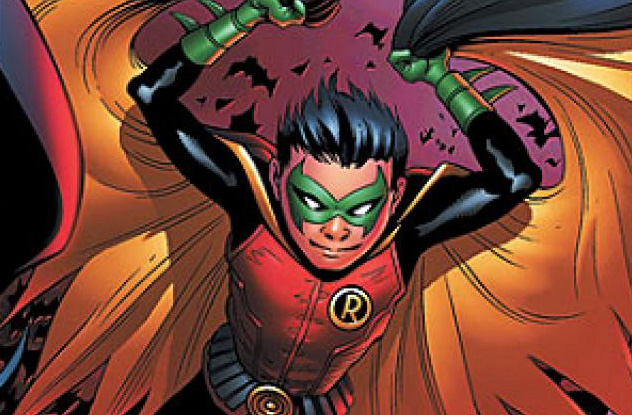
The role of Robin has been inhabited by Dick Grayson (the original, who went on to become Nightwing), Jason Todd (the first replacement, beaten with a crowbar before dying in a bomb blast), Tim Drake (who deduced Batman’s secret identity and felt like he needed a partner), and Damian Wayne (Batman’s son, killed by his own clone).
Batman is a 75-year-old comic, so it makes some sense that he’s had so many sidekicks. The comic’s ambiguous timeline means that the Caped Crusader had 10 or 15 years to amass this small army of sidekicks.
However, one of DC’s more interesting decisions was to create a “New 52” continuity, in which superheroes have only been working for five years. The vast majority of Batman’s stories (and sidekicks) still happened in this newer, shorter continuity. So Batman took in, trained, and either drove off or got killed no less than four children in five years.
2Every Batman Story Is Connected
In most franchises, a beloved story from the ’30s may no longer be canonical due to editorial whim. A beloved movie may have no bearing on the comics. They’re different mediums, different stories, and different storytellers. However, for one Bat scribe, all of the stories are connected.
During Grant Morrison’s lengthy tenure, he approached the Batman mythos quite differently from traditional writers. He envisioned that Batman’s various stories represent different time periods in the character’s life. For instance, the earliest Batman stories—in which a gun-wielding Batman isn’t afraid to kill criminals—represent a 20-year-old wild Batman. Meeting Robin makes him think of the innocence he lost, so he becomes a more moral, fatherly figure.
The zaniness of the old Adam West Batman TV show is explained as the effect of numerous mind-altering chemicals on the duo’s brains, causing them to see visualizations of sound effects such as “Bam” and “Pow.” Dick Grayson moving out and becoming Nightwing ties into the ’70s playboy-esque Batman, who moves to a penthouse, romances Talia Al Ghul, and is drawn with some wicked chest hair. Morrison envisions the modern Batman as the culmination of all of his experiences, explaining Batman’s thoughts as: “Once I was funny, once I was sexy, once I was weird, now I’m this. I’m all of them.”
No word on where the Batman and Robin bat nipples fit into all this, but they certainly meet the qualifications of being funny, sexy, and weird.
1Batman Killed The Joker
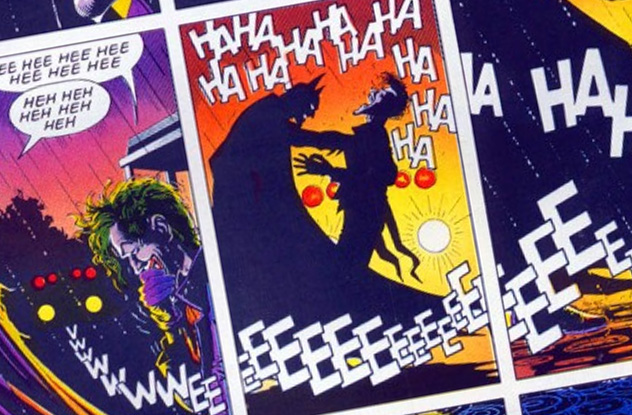
Many readers question Batman’s unwavering policy of never killing villains such as the Joker. But in one Batman comic, you may very well get to see him violate this policy in the most direct way possible.
Comics scribe Alan Moore, known best for such works as Watchmen and League of Extraordinary Gentlemen, penned a wonderful stand-alone Batman comic called The Killing Joke. The plot centers around Joker paralyzing Barbara Gordon and kidnapping the Commissioner, hoping to prove that everyone is like the Joker—just one bad day away from going insane. It’s a powerful story, and it inspired the plot of the film The Dark Knight.
For many, though, the comic ends quite strangely. Joker tells an odd story about two people who escape an asylum via the rooftop. One of them is scared of heights and doesn’t want to jump to the next roof, and the other offers to turn on a flashlight so the man can walk along the beam of light. The first man screams, “What do you think I am? Crazy? You’d turn it off when I was halfway across!” Joker laughs, and then Batman laughs as well. A police car pulls up, its headlights forming two beams of light. Batman reaches out while they are still laughing. Then, in the final panel, both the laughter and the light have stopped.
You can interpret the ending in multiple ways, but according to Grant Morrison, Batman kills Joker at the end of the story. When he reaches out, he does so to strangle the Joker. The light goes out to represent that there is now no way for Batman to jump to the next metaphorical roof, so he falls short of his goal and gives in.
Morrison says this moment is key to the comic’s title. Joker’s joke is a “killing joke” in that it prompts Batman to kill him.
Tell Chris your favorite Bat moment @PocketEpiphany.




